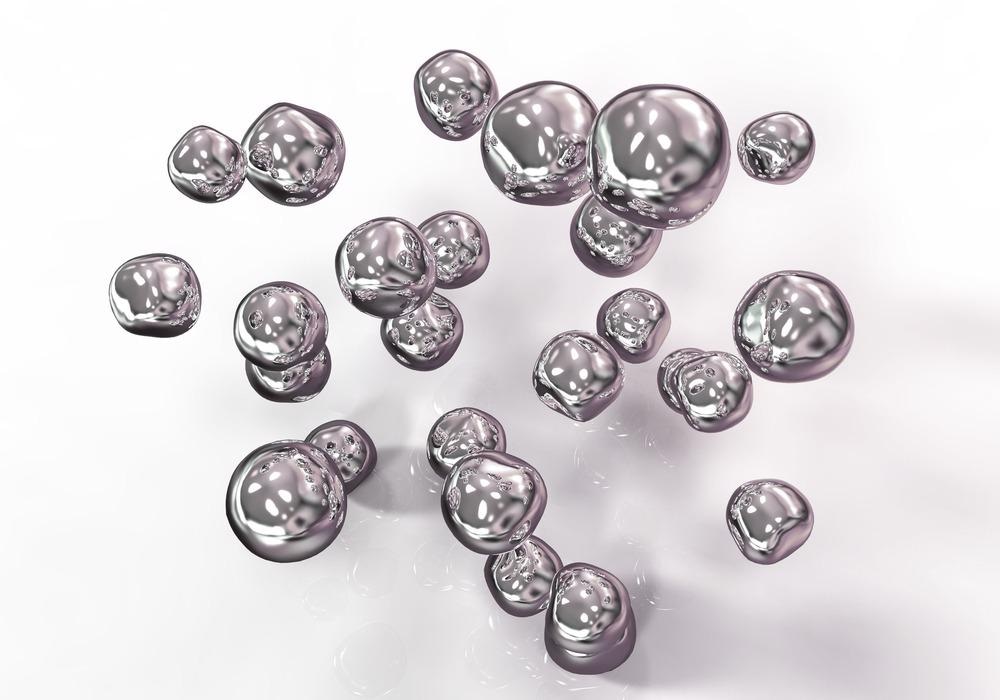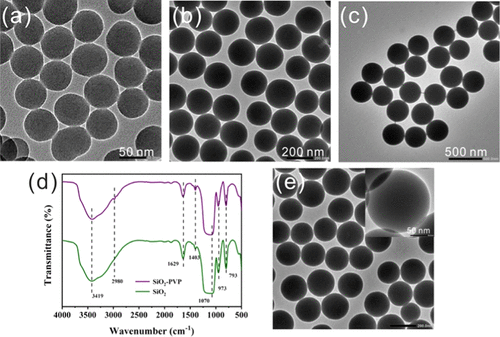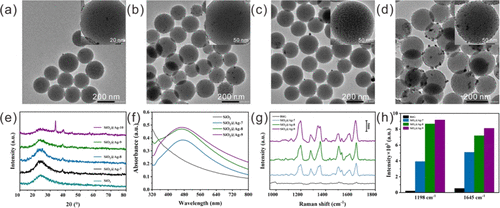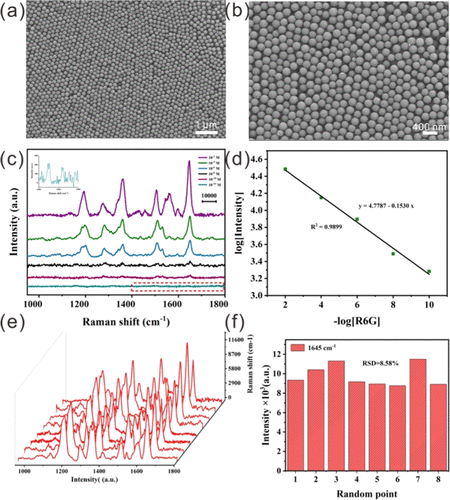In a study published in the journal ACS Omega, SERS substrates composed of SiO2@Ag composite and SiO2@Ag matrix were utilized to analyze the Raman frequencies of weak solutions of rhodamine 6G (represented as R6G), a natural dye that is a possible environmental contaminant. The results suggest that the developed SiO2@Ag composite and SiO2@Ag matrix are viable SERS platforms.

Study: Silver Nanoparticle-Decorated Silica Nanospheres and Arrays as Potential SERS Substrates. Image Credit: Kateryna Kon/Shutterstock.com
What is Surface-Enhanced Raman Scattering?
Owing to its great sensitivity, small sensing limit, live tracking without time-intensive sample preparation, and adequate access to data in the molecular fingerprint area, the surface-enhanced Raman scattering (SERS) approach has been used in a variety of disciplines, including biomedical science, chemistry, environmental inspection, and food hygiene.
So far, the chemical and electromagnetic mechanisms (denoted as CM and EM respectively) have been widely accepted for SERS augmentation. CM is caused by the exchange of electrons between the molecular target and the surface of the substrate, while EM is associated with hot spots that are determined by the abrasiveness of metallic nanoparticles (NPs) and the nanoscale gaps between surrounding NPs. On a nanosized scale, the SERS intensity is strongly dependent on the morphology and chemical makeup of the SERS substrate. To acquire effective Raman frequencies and enable broad use of the SERS technology, it is critical to develop SERS platforms with a high sensitivity of Raman scatter, acceptable reproducibility, and minimal cost.

TEM images of SiO2 nanoparticles with a size of (a) 50 nm, (b) 150 nm, and (c) 300 nm. (d) FTIR spectra of the pure SiO2 and PVP-modified SiO2. (e) TEM image of PVP-capped SiO2.© Li, J., Xu, Y., Tian, L., Yan, Y., Niu, L., Li, X., & Zhang, Z. (2021)
Choosing the Right Substrate for SERS
Noble metals (like gold and silver), particularly silver nanoscale structures, are attractive SERS platforms due to their distinctive plasmonic capabilities in the visible and near-IR spectrum ranges, and also their lower cost as opposed to gold.
The noble metal SERS-active platforms, particularly their NPs in a colloidal mixture, offer the benefits of being simple to prepare and having adjustable optic characteristics. Nonetheless, eliminating the agglomeration of NPs during stochastic growth continues to be a difficulty.
Metallic NP agglomeration is typically unavoidable, and the "hot spots" produced by the clusters often demonstrate unsatisfactory substrate stability and reproducibility. To address this issue, one method is to integrate silver NPs onto or into a variety of robust arrays to generate composites.
This method, which uses robust matrices as bearers, has two benefits. Stable matrices may enhance the reactive areas of metallic nuclei, preventing randomized agglomeration. Or alternatively, they may form additional "hot spots," comprising not only metallic NPs but also nanoscale gaps between surrounding metallic NPs. It may be possible to develop a large number of "hot spots" and enhance the concentration of "hot spots" in the substrates using this method. SERS platforms with uniform and organized array frameworks have an edge over those composed of typical metallic composites.

(a–d) TEM images of SiO2@Ag composites obtained under a reaction solution pH of 7, 8, 9, and 10 and their (e) XRD patterns, (f) UV–vis spectra, and (g) Raman spectra as well as (h) corresponding signal intensities of the absorbance peaks at 1198 and 1645 cm–1 © Li, J., Xu, Y., Tian, L., Yan, Y., Niu, L., Li, X., & Zhang, Z. (2021)
A Spherical Silica Core
Spherical silica might be an effective core or endorser in the research or implementation of SERS with noble NPs, owing to its exceptional properties like mono-dispersion, excellent visual transparency and thermal stability, strong cytocompatibility, and easy production.
Moreover, surface modification of silica is simple. The grafted functional groups on the SiO2 surface may produce clinical locations for the adhesion and development of silver NPs via the terminal groups, potentially contributing to improved SERS. The team provided a simple and adaptable approach for creating a silver NP-decorated raspberry-like silica composite (SiO2@Ag) as a new SERS platform.

(a, b) FESEM images of SiO2@Ag arrays. (c) SERS spectra of R6G solutions with concentrations ranging from 10–11 to 10–2 M. (d) Logarithm of the SERS intensity of R6G at 1645 cm–1 as a function of the negative logarithm of R6G concentration. (e) Raman spectra of SiO2@Ag arrays and (f) the corresponding peak intensities of eight randomly measured sites at 1645 cm–1 © Li, J., Xu, Y., Tian, L., Yan, Y., Niu, L., Li, X., & Zhang, Z. (2021)
To Conclude
This article describes the production of the SiO2@Ag composite and SiO2@Ag matrices, along with their implementation as SERS platforms for the tracking of rhodamine 6G (denoted R6G), a frequently used natural pigment that is a possible environmental contaminant.
To create the SiO2@Ag composite, silver NPs are formed on the surface of SiO2 nanospheres with the involvement of PVP as both a modulator and a reductant. As an array, silica nanospheres may inhibit silver NP agglomeration and allow the production of a large number of exploitable "hot spots" in the nanoscale gap for strong SERS augmentation.
Additionally, SiO2@Ag matrices were built via evaporation-triggered self-assembly of SiO2@Ag. The prepared SiO2@Ag composite and SiO2@Ag arrays with good metallic coverage, excellent stability, and a lot of "hot spots" might be viable SERS platforms with the requisite Raman frequency amplification capabilities. Particularly, SiO2@Ag arrays as the SERS platform can detect R6G at low concentrations with high reproducibility and reliability, indicating great potential for biochemical molecular detection.
Continue reading: How Can DLC Tribofilms be Analyzed Through Raman Spectroscopy?
Reference
Li, J., Xu, Y., Tian, L., Yan, Y., Niu, L., Li, X., & Zhang, Z. (2021). Silver Nanoparticle-Decorated Silica Nanospheres and Arrays as Potential Substrates for Surface-Enhanced Raman Scattering. ACS Omega, 6, 32879-32887. Availabe at: https://doi.org/10.1021/acsomega.1c04874
Disclaimer: The views expressed here are those of the author expressed in their private capacity and do not necessarily represent the views of AZoM.com Limited T/A AZoNetwork the owner and operator of this website. This disclaimer forms part of the Terms and conditions of use of this website.